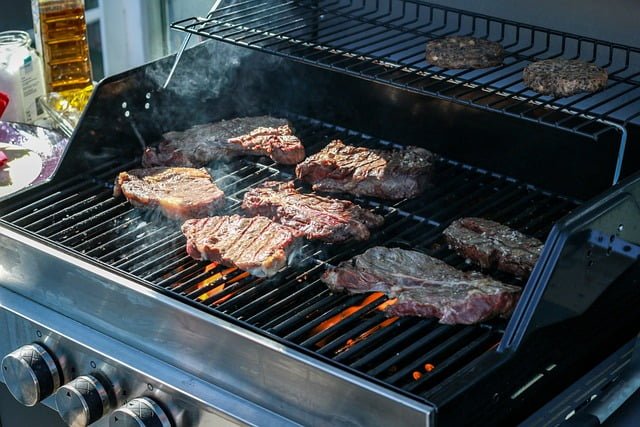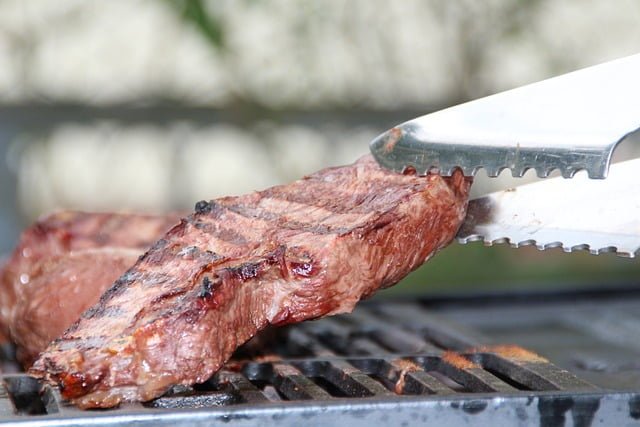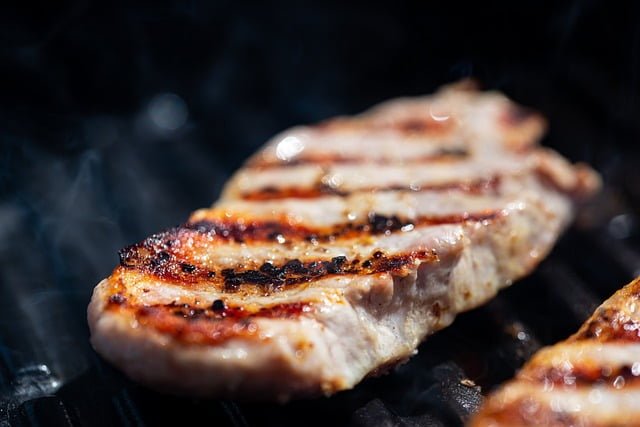Slowing cooking ribs on a gas grill is a great way to achieve that smoky, tender flavor that we all crave. However, it can be a bit intimidating for those who have never done it before. But fear not, because we have a simple and easy-to-follow guide on how to slow cook ribs on a gas grill.

First and foremost, it’s important to choose the right type of ribs. St. Louis-style spare ribs or baby back ribs are both great options for slow cooking on a gas grill. Once you have your ribs, you’ll want to prepare them by removing the membrane on the back of the ribs and seasoning them with your favorite dry rub. From there, it’s all about setting up your grill for indirect heat and letting the ribs cook low and slow.
Table of Contents
Understanding Your Gas Grill
Getting to Know the Parts
Before we start slow cooking ribs on a gas grill, it’s important to understand the different parts of the grill. Here are the main parts of a gas grill:
| Part | Description |
|---|---|
| Lid | Covers the grill and helps trap heat inside. |
| Cooking Grates | Where the food is placed to cook. |
| Burners | Tubes that run under the cooking grates and produce heat. |
| Drip Pan | Collects grease and other drippings from the food. |
| Igniter | Lights the burners to start the grill. |
| Gas Tank | Holds the propane or natural gas that fuels the grill. |
Temperature Control
One of the keys to slow cooking ribs on a gas grill is temperature control. Here are some tips for controlling the temperature of your grill:
- Preheat the grill: Turn on the burners and close the lid for 10-15 minutes before adding the food. This will allow the grill to reach the desired temperature and ensure even cooking.
- Use the burners: Turn on one or two burners and leave the others off to create different temperature zones on the grill. This allows you to cook different foods at different temperatures.
- Adjust the vents: Most gas grills have vents on the lid and the bottom of the grill. Opening and closing these vents can help control the temperature and the amount of oxygen that reaches the burners.
- Use a thermometer: Use a meat thermometer to check the internal temperature of the ribs. This will help you determine when they are done and prevent overcooking.
By understanding the different parts of your gas grill and how to control the temperature, you’ll be able to slow cook ribs to perfection.
Choosing the Right Ribs
When it comes to slow cooking ribs on a gas grill, choosing the right type of ribs is crucial. Here are some factors to consider when selecting ribs for your recipe:
Type of Ribs
There are several types of ribs to choose from, including baby back ribs, spare ribs, and St. Louis-style ribs. Baby back ribs are smaller and leaner, while spare ribs are larger and fattier. St. Louis-style ribs are a type of spare rib that has been trimmed to remove the brisket bone and cartilage, resulting in a more uniform shape.
Quality of Ribs
When selecting ribs, it’s important to choose high-quality meat. Look for ribs that are fresh and well-marbled, with a good amount of fat. The meat should be firm to the touch and free of any discoloration or odor.
Quantity of Ribs
When deciding how many ribs to buy, a good rule of thumb is to plan for about 1/2 to 3/4 pound of ribs per person. Keep in mind that ribs will shrink as they cook, so it’s better to err on the side of caution and buy a little more than you think you’ll need.
Seasoning and Sauces
Finally, consider the seasonings and sauces you plan to use when choosing your ribs. Some types of ribs may be better suited to certain flavors or cooking methods. For example, baby back ribs are often seasoned with sweet or fruity flavors, while spare ribs may be better suited to savory or spicy seasonings.
By considering these factors when selecting your ribs, you can ensure that your slow-cooked ribs turn out delicious and flavorful.
Preparation of Ribs
Preparing ribs for slow cooking is an essential step to ensure that they come out tender and juicy. In this section, we will cover the two main steps of preparation: cleaning and trimming, and marinating and seasoning.
Cleaning and Trimming
Before cooking, it’s important to clean and trim the ribs to remove any unwanted fat or debris. Here are the steps to follow:
- Remove the membrane: The membrane on the underside of the ribs can be tough and chewy, so it’s best to remove it. Use a sharp knife to loosen one corner of the membrane, then pull it off with a paper towel.
- Trim excess fat: Trim any large areas of fat from the ribs. A little bit of fat is okay, but too much can make the ribs greasy and unappetizing.
- Rinse the ribs: Rinse the ribs under cold water and pat them dry with paper towels.
Marinating and Seasoning
Marinating and seasoning the ribs is what gives them their flavor. Here are some tips for doing it right:
- Choose your marinade: There are many different marinades you can use, from sweet and tangy to spicy and savory. Choose one that complements the flavor of your ribs.
- Apply the marinade: Place the ribs in a large zip-top bag and pour the marinade over them. Seal the bag and massage the marinade into the meat to ensure it’s evenly coated. Marinate the ribs in the refrigerator for at least 2 hours, or overnight for maximum flavor.
- Season the ribs: Before cooking, season the ribs with a dry rub or your favorite spices. Be sure to apply the seasoning evenly on both sides of the ribs.
By following these preparation steps, we can ensure that our slow-cooked ribs turn out delicious every time.

Slow Cooking Process
Setting the Temperature
To begin slow cooking ribs on a gas grill, we need to set the temperature correctly. First, turn on the grill and preheat it to 225°F. This temperature is ideal for slow cooking the ribs and will give them a tender and juicy texture.
Grilling the Ribs
Once the grill is preheated, we can place the ribs on the grill. We recommend using indirect heat to slow cook the ribs. This means placing the ribs on the unlit side of the grill and closing the lid. It’s important to keep the lid closed during the cooking process to maintain a consistent temperature.
We can also add wood chips or chunks to the grill to add a smoky flavor to the ribs. Hickory, mesquite, and applewood are popular choices for smoking ribs.
Checking the Doneness
After about 3-4 hours of slow cooking, we can check the doneness of the ribs. The internal temperature of the meat should reach 190°F to 203°F for fully cooked and tender ribs. We can use a meat thermometer to check the temperature.
Another way to check the doneness is by bending the ribs. If the meat starts to tear away from the bone, the ribs are done. It’s important not to overcook the ribs as they can become tough and dry.
That’s it for the slow cooking process of ribs on a gas grill. With these simple steps, we can achieve delicious and tender ribs every time.
Resting and Serving
Letting the Ribs Rest
Once the ribs are fully cooked, it’s important to let them rest for a few minutes before slicing and serving. This allows the juices to redistribute throughout the meat, resulting in more tender and flavorful ribs.
To rest the ribs, simply remove them from the grill and place them on a large cutting board or platter. Cover them loosely with aluminum foil and let them rest for 5-10 minutes. This will also give you time to prepare any sides or sauces you plan to serve with the ribs.
Slicing and Serving
When it’s time to serve the ribs, remove the foil and use a sharp knife to slice them between the bones. Aim for slices that are about 1/2 inch thick, and be sure to cut against the grain of the meat to ensure maximum tenderness.
Once the ribs are sliced, you can arrange them on a platter and serve them with your favorite sides and sauces. Some popular options include coleslaw, baked beans, corn on the cob, and potato salad. Don’t forget to provide plenty of napkins, as ribs can be messy to eat!
Overall, slow-cooking ribs on a gas grill is a great way to achieve tender, juicy, and flavorful results. By following these simple steps and taking your time, you can create delicious ribs that are sure to impress your friends and family.
Cleaning and Maintenance of Gas Grill
Maintaining your gas grill is crucial to ensure that it lasts for a long time and functions properly. Here are some tips for cleaning and maintaining your gas grill:
- Clean the grates after every use: Use a grill brush or scraper to remove any food debris or grease from the grates. This will prevent them from sticking to the grates and make them easier to clean in the future.
- Clean the burners regularly: Remove the burners and clean them with a wire brush or scraper to remove any dirt or debris. This will ensure that the burners function properly and prevent any blockages that could cause the grill to malfunction.
- Clean the grease tray: The grease tray collects all the grease and oil that drips from the food while cooking. Empty the tray after every use and clean it with warm soapy water to prevent any buildup that could cause a fire hazard.
- Clean the exterior: Use a damp cloth or sponge to clean the exterior of the grill. Avoid using harsh chemicals or abrasive cleaners that could damage the finish.
- Check for leaks: Regularly inspect the gas hoses and connections for any leaks. Apply a soapy water solution to the connections and look for bubbles. If you detect any leaks, turn off the gas supply and have a professional repair it.
By following these simple tips, you can ensure that your gas grill functions properly and lasts for a long time.

Frequently Asked Questions
What are the different types of pork ribs?
There are three main types of pork ribs: baby back ribs, St. Louis-style ribs, and spare ribs. Baby back ribs are shorter and leaner than the other two types, while St. Louis-style ribs are meatier and have more fat. Spare ribs are the largest of the three and have the most fat.
How can we achieve fall-off-the-bone ribs on a gas grill?
To achieve fall-off-the-bone ribs on a gas grill, we need to slow cook them at a low temperature for several hours. This will break down the connective tissue in the meat and make it tender. We can also add a liquid, such as apple juice or beer, to the grill to create steam and keep the ribs moist.
What is the best way to slow cook ribs on a gas grill without foil?
To slow cook ribs on a gas grill without foil, we can use a rib rack or place the ribs directly on the grill grates. We can also use a smoker box or wrap wood chips in aluminum foil and place them on the grill to add smoky flavor. It’s important to monitor the temperature of the grill and adjust the heat as needed to maintain a consistent temperature.
At what temperature should we slow cook ribs on a gas grill?
We should slow cook ribs on a gas grill at a temperature between 225°F and 250°F. This low temperature will allow the ribs to cook slowly and evenly without drying out. We can use a meat thermometer to ensure that the internal temperature of the ribs reaches 190°F to 203°F.
Is it possible to slow cook on a gas grill?
Yes, it’s possible to slow cook on a gas grill. We can use the indirect grilling method, which involves turning off one or more burners and placing the food on the cooler side of the grill. This allows the food to cook slowly and evenly without direct heat.
Should we wrap our ribs in foil when slow cooking on a gas grill?
Wrapping ribs in foil when slow cooking on a gas grill is optional. Foil can help keep the ribs moist and tender, but it can also prevent them from developing a crispy bark. If we choose to wrap our ribs in foil, we should do so after a few hours of cooking and add a liquid, such as apple juice or beer, to the foil packet.





